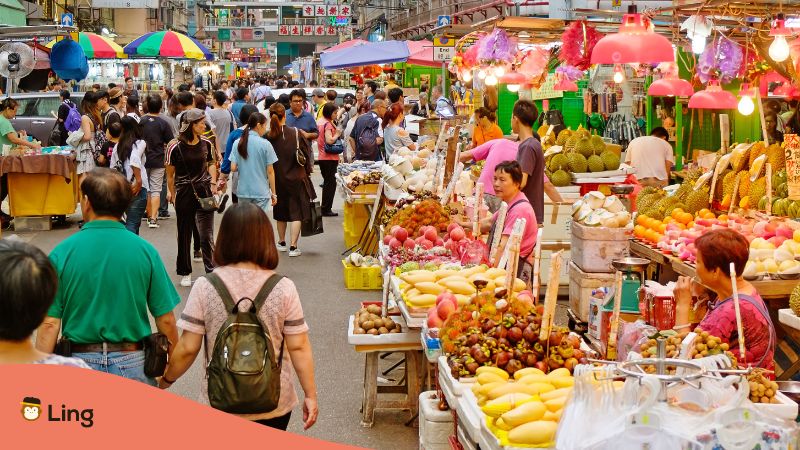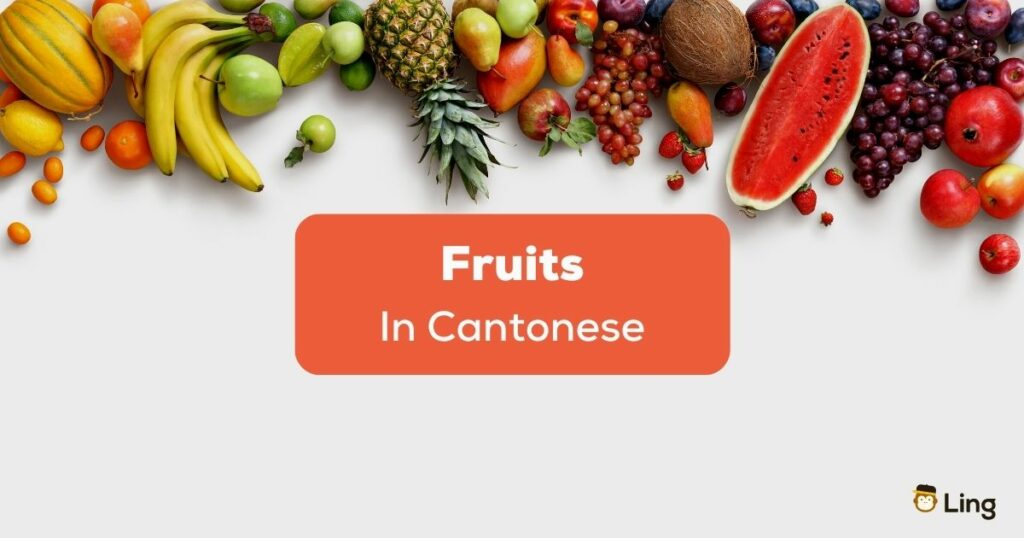Craving fresh and delicious fruits 水果 (seoi2 gwo2)? In this post, we’ll go over the basic fruits in Cantonese so that you can start feeling confident about ordering your favorite fruits at the market. After all, Hong Kong is a haven not just for luxury shopping and sightseeing but also for amazing fruits. Who knows? Learning some basic words may help you communicate and connect better with the locals!
Aside from vegetables (蔬菜 so1 coi3) like carrots, 紅蘿蔔 (hung4 lo4baak6), cabbage 椰菜 (je4 coi3), and potato (薯仔 syu4 zai2), there is another source of vitamins and minerals – fruits. It is a delicious food that people from different parts of the world love. Fruits are essential in Hong Kong as they provide a wide range of health benefits and are a significant part of the traditional Chinese diet. Additionally, fruits are also important in Hong Kong’s economy as it is one of the major agricultural products exported from the region. Want to learn more? Keep reading below!
What Are The Names Of The Fruits In Cantonese
Cantonese speakers use the word 水果 (seoi2 gwo2) to say ‘fruit’ in Cantonese. In this part of the blog, you will find some basic fruits in Cantonese.
1. Apple – 蘋果 (Ping4 Gwo2)
Apple 蘋果 (Ping4 Gwo2) is among the most common delicious fruits in Hong Kong markets. You can buy high-quality regular-sized or jumbo China fuji apples. There are also other types of apples, such as the envy apple and the USA red apple. In Cantonese cuisine, apples are often used in sweet dishes, such as desserts and pastries, and in savory dishes, as a flavor ingredient, such as in braised meats.
2. Longan (龍眼 Lung4 Ngaan5)
Aside from the standard fruits, Hong Kong also has a variety of uncommon fruits, like the longan (龍眼 lung4 ngaan5). This fruit is like lychee. Longan, which translates to “dragon eyes” in Cantonese, is a more traditional and refined fruit with large seeds, translucent meat, and a thin yellow-brown peel sold by the bunch. It is less treacly and equally delectable. In Cantonese cuisine, Longans are often used in sweet dishes and desserts, such as soups and sweet soups, or as a snack and can also be preserved in syrup.
3. Mango – 芒果 (Mong1 Gwo2)
Have you tried the delicious Cantonese-style dessert Mango Pomelo Sago? That would not be as good as it is without the star fruit – mango 芒果 (mong1 gwo2). One of the most common mangoes that you can see in Hong Kong is the Eagle mango. Mango trees are growing throughout Hong Kong. But did you know that the Sikhs and Punjabis who came to the city to serve its uniformed forces are responsible for the presence of these mango trees? They were the soldiers who first planted mango trees in Hong Kong.
Pear – (梨 Lei4)
Another common fruit in the Hong Kong market is the pear (梨 lei4). You can find different pears in Hong Kong, such as Packham pear and royal pear. A pear has a fibrous interior and is a soft, sweet fruit. They are abundant in dietary fiber, plant chemicals, and important antioxidants. Pears are also believed to have medicinal properties, which is why they are often used in traditional Chinese medicine.
Salak/ Snake Fruit – 蛇皮果
Salak, often referred to as the snake fruit, informally has a creepily snakeskin-like exterior. However, after the sharp shell is removed, you’ll discover a rich, creamy interior that doesn’t taste reptile-like. Salak is easily transformed into an alcoholic beverage that roughly resembles wine made from grapes. Although it is typically eaten fresh, it can also be pickled.

4. Mangosteen – 山竹果 (Saan1 Zuk1 Gwo2)
One of the most treasured tropical fruits, mangosteen, is hailed as the “Queen of Fruits” for its exquisite purple-blue pericarp and mouthwatering taste. Nothing compares to the mangosteen’s sweet, gooey white meat encased in a thick purple shell and resembles a fermenting garlic bulb. Southeast Asia views this fruit as the supreme species (the king being durian). Simply grasp one with both hands and twist it down the middle to separate the rind from the edible bits. It doesn’t require much handling.
5. Rambutan – 紅毛丹 (Hung4 Mou4 Daan1)
Ready for another uncommon fruit? Here’s rambutan for you. Rambutans have spiky, threatening shells that conceal large meat bulbs, making them the sea urchins of fruits. Each bite is brimming with sweet juice; they’re like lychees on steroids. In Cantonese cuisine, rambutan is mainly used as a fresh fruit, eaten on its own as a snack, or used in sweet desserts. It is not commonly used as an ingredient in savory dishes.
6. Jackfruit – 大樹菠蘿 (Daai6 Syu6 Bo1 Lo4)
While the jackfruit may resemble its powerful sibling, the durian, its delicious, pale yellow flesh is considerably gentler and less divisive; once you start eating it, it’s difficult to stop. Because the fruit is covered in a hard, prickly husk, it is occasionally marketed without the shell for easier eating.
Jackfruit is a huge fruit with thick, edible seeds, pods, and yellow flesh. The flesh has a distinct, sweet flavor that some compare to a mixture of banana and pineapple. People frequently utilize jackfruit flesh as a meat substitute in vegetarian and vegan meals because of its fibrous texture.
7. Wax Apple – 蓮霧 (Lin4 Mou6)
The fruit’s liquid-to-flesh ratio can be compared to a watermelon, and wax apples have a taste that is somewhat similar to snow pears. Even the wax apple’s seed is edible but has no flavor. Wax apples are used in traditional medicine to treat a variety of illnesses.
8. Watermelon – 西瓜 (Sai1 Gwaa1)
Lastly, we have watermelon 西瓜 (sai1 gwaa1). You can also find various watermelons in Hong Kong, such as Black Beauty Melon, Kimmy Melon, Mini Watermelon, Tin Huang Melon, Bambino Watermelon China, and more. But what’s interesting is that there’s a watermelon that costs US$750 in Hong Kong!
Learn How To Name More Fruits In Cantonese!
Now that you have learned the basics, here’s a list of other fruits in Cantonese.
| English | Cantonese | Jyutping Romanization |
| apricot | 杏 | hang6 |
| avocado | 牛油果 | ngau4 jau4 gwo2 |
| bananas | 香蕉 | hoeng1 ziu1 |
| blueberry | 藍莓 | laam4 mui2 |
| cherry | 車厘子 | ce1 lei4 zi2 |
| cranberry | 紅莓 | hung4 mui2 |
| corn | 粟米 | suk1 mai5 |
| dragon fruit | 火龍果 | fo2 lung4 gwo2 |
| fig | 無花果 | mou4 faa1 gwo2 |
| grape | 葡萄 | pou4 tou4 |
| grapefruit | 西柚 | sai1 jau2 |
| green apple | 青蘋果 | ceng1 ping4 gwo2 |
| kiwi | 奇異果 | kei4 ji6 gwo2 |
| lemon | 檸檬 | ning4 mung1 |
| melon | 蜜瓜 | mat6 gwaa1 |
| orange | 橙 | caang2 |
| peach | 桃 | tou2 |
| pineapple | 菠蘿 | bo1 lo4 |
| pomelo | 碌柚 | luk1 jau2 |
| plum | 布冧 | bou3 lam1 |
| prune | 梅乾 | mui4 gon1 |
| raspberry | 紅莓 | hung4 mui2 |
| strawberry | 士多啤梨 | si6 do1 be1 lei2 |
| tomato | 蕃茄 | faan1 ke2 |
Vocabulary Related To Fruits In Cantonese
| English | Cantonese | Jyutping Romanization |
| delicious | 好吃 | hou2 hek3 |
| fresh fruit | 新鮮水果 | san1 sin1 seoi2 gwo2 |
| fruit shop | 生果鋪 | saang1 gwo2 pou1 |
| fruit juice | 果汁 | gwo2 zap1 |
| juicy | 多汁 | do1 zap1 |
Want To Have A Fruitful Language Learning Experience?

Nowadays, learning another language is an edge. That’s why many people are learning and looking for a convenient way to learn a new language. Good thing that the Ling app can help people with that goal!
With Ling, you can learn Cantonese and other languages anytime and anywhere. You can choose from a variety of topics you like and learn them in a fun and engaging way. You can also develop your language skills because every vocabulary that you will learn will have a translation in the form of your native language. You can also learn from example sentences with audio recordings from native speakers. So what are you waiting for? Download the Ling app now to start learning Cantonese now!



































































